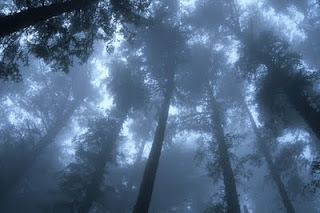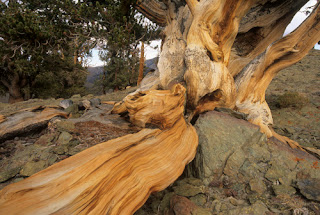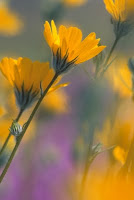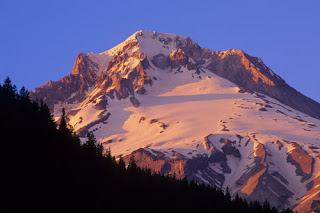Look Down: In our quest to find the next great vista, many times photographers forget to look down at the ground in front of them. At your feet is an endless supply of graphic designs waiting to be recorded on film. Pine cones nestling on a bed of needles, a tiny wildflower swimming in a sea of grass, or layers of rock sweeping across a desert are just a few of the millions of possibilities. If you don't live anywhere near a wilderness, or you are just plain bored with your surroundings, or you are stuck watching the kids in the backyard, looking down is a sure-fire remedy to get out of a rut and start creating images.
 Look Up: More than once, while photographing a scene overhead, hikers walk by, gasp, and confess they never would have noticed the scene if I hadn't been by the side of the trail with my camera. Many times a mediocre photo trip has been saved by a pocket of mist in the canopy of the trees far overhead. The message is simple, don't forget to look up. Above you might be soaring tree trunks, brilliantly lit alpine peaks, or a crescent moon peeking around a cliff. At the very least, you will stretch your aching neck muscles.
Look Up: More than once, while photographing a scene overhead, hikers walk by, gasp, and confess they never would have noticed the scene if I hadn't been by the side of the trail with my camera. Many times a mediocre photo trip has been saved by a pocket of mist in the canopy of the trees far overhead. The message is simple, don't forget to look up. Above you might be soaring tree trunks, brilliantly lit alpine peaks, or a crescent moon peeking around a cliff. At the very least, you will stretch your aching neck muscles. Change Your Perspective: If you ever run into a professional nature photographer in the field at work, chances are they are on their knees or even on their stomach. Why do we spend all that time on the ground? Well, frankly, images taken at eye-level are for the most part (how should I put this delicately?) BORING! We spend most of our lives seeing the world at eye-level. Any photograph taken at a different height becomes unique and interesting. So the next time you are framing the image, remember to try to get low. It just might make a world of difference.
Change Your Perspective: If you ever run into a professional nature photographer in the field at work, chances are they are on their knees or even on their stomach. Why do we spend all that time on the ground? Well, frankly, images taken at eye-level are for the most part (how should I put this delicately?) BORING! We spend most of our lives seeing the world at eye-level. Any photograph taken at a different height becomes unique and interesting. So the next time you are framing the image, remember to try to get low. It just might make a world of difference. Narrow Your Focus: Most closeup images I see suffer from distracting backgrounds. As nature photographers, we may be tempted to try to get as much in focus as possible, but that can be the death blow to a macro image. Use the largest aperture as practical (think f/4 or f/5.6). The large opening in the lens will only allow for a very narrow depth of field. That, however, is exactly what you are looking for. Shoot wide open, focus perfectly on the subject, and watch the background change from your neighbor's cluttered lawn to beautiful curtains of pastel draped across the image. As an added bonus, wide open apertures allow for faster shutter speeds. That allows you to freeze that flower in a slight (and I stress slight) breeze. A win-win situation and those rarely happen in this business.
Narrow Your Focus: Most closeup images I see suffer from distracting backgrounds. As nature photographers, we may be tempted to try to get as much in focus as possible, but that can be the death blow to a macro image. Use the largest aperture as practical (think f/4 or f/5.6). The large opening in the lens will only allow for a very narrow depth of field. That, however, is exactly what you are looking for. Shoot wide open, focus perfectly on the subject, and watch the background change from your neighbor's cluttered lawn to beautiful curtains of pastel draped across the image. As an added bonus, wide open apertures allow for faster shutter speeds. That allows you to freeze that flower in a slight (and I stress slight) breeze. A win-win situation and those rarely happen in this business. Isolate Your Idea: My college instructor shouted this suggestion out at critique twenty years ago and it still rings in my ears today, "FILL THE FRIGGIN' FRAME!" I have one complaint about most photos I see; the subject is lost somewhere in the rest of the clutter on the image. If you want to include the foreground in your shot, that's fine. However, if you really want the viewer to be amazed by the brilliant last light of day shining on that distant peak, you better use a telephoto lens to isolate the mountain in the frame. If you don't have a long enough lens you can always crop the image in the computer later on.
Isolate Your Idea: My college instructor shouted this suggestion out at critique twenty years ago and it still rings in my ears today, "FILL THE FRIGGIN' FRAME!" I have one complaint about most photos I see; the subject is lost somewhere in the rest of the clutter on the image. If you want to include the foreground in your shot, that's fine. However, if you really want the viewer to be amazed by the brilliant last light of day shining on that distant peak, you better use a telephoto lens to isolate the mountain in the frame. If you don't have a long enough lens you can always crop the image in the computer later on.Most people spend their lives in a form of tunnel vision, viewing the world through eye level. Most nature photographers spend most of their lives trying to escape that viewpoint to create amazing photos. On your next photography trip, try some of the ideas above to mix up your life's viewpoint a little bit and come home with a great image.

No comments:
Post a Comment